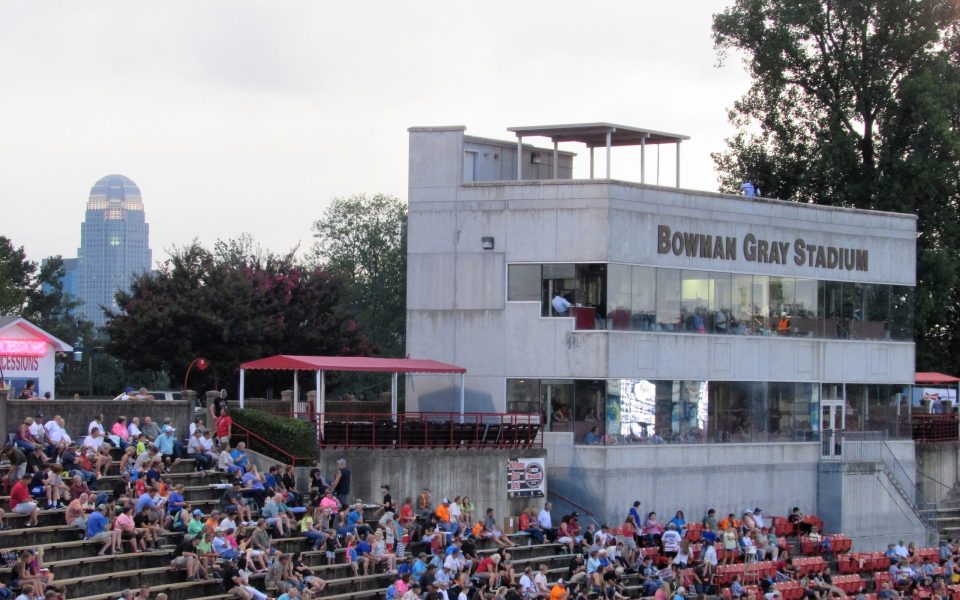Engines squalled throatily. The black car out front, No. 44, had a healthy lead of a dozen lengths on its closest competitor and while the driver eased up on the urgent tightness of the turns, the middle of the pack scrambled for placement. The leader, still No. 44, maintained its lead through the end, a celebratory fist thrusted out the side of the cockpit as the checkered flag fluttered.
The top flapped up and open. A kid, Josh Kossek of Tobaccoville, hopped out of the Bandolero mini stock car, both arms raised in a V, and stepped onto the winner’s circle in the early evening of Aug. 5.
“How old are you?” the emcee asked Kossek.
“Twelve,” he replied with the subdued aloofness of one on the verge of puberty.
“Only 12 years old, and you’re a winner at Bowman Gray Stadium. How does it feel?”
“Great.”
Racing fans call Winston-Salem’s Bowman Gray Stadium the “Madhouse.” That nickname might initially strike an observer as a bit hyperbolic or unfitting for the tiny oval — at a quarter-mile, a minuscule circuit when compared to the legendary Indianapolis Brickyard. But it’s a nickname that’s stuck with the short track for over 50 years.
Bowman Gray Stadium may not inspire awe in the way its big siblings do in Charlotte or Daytona, but despite its outward humility and appearance, the Madhouse boasts just as many historic moments and legacies.
For one, Bowman Gray poses a strong argument for the title of longest-running weekly race track in NASCAR history. The stadium hosted its first NASCAR event on May 18, 1949; on Aug. 15, 2015, the Madhouse held its 1,000th officially sanctioned race.
Richard Petty — the King, the winningest stock-car racer of all — took his 100th victory at Bowman Gray on Aug. 22, 1969, driving a Ford instead of the Plymouths associated with his reign. That was just his halfway point.
Many other NASCAR legends took checkered flags in Winston-Salem during the Madhouse’s Grand National Cup glory days. Junior Johnson matched the King’s tally of four before he went into the crappy knockoff moonshine business. The record for most Cup wins goes to Taylorsville’s Rex White with six.
Strangely enough, the Madhouse holds a double legacy: football field. The Wake Forest University Demon Deacons competed in Bowman Gray from 1956 until 1967. Running back Brian Piccolo of Brian’s Song fame, who led the nation in rushing yards and scoring in 1964, played all his home games there. The Winston-Salem State University Rams shared the stadium during the same time and continue to play ball there. Efforts by the university to purchase Bowman Gray have been contentious and controversial — another story for another time.
Since the Madhouse dropped off as a premier venue in the ’70s, the NASCAR tradition at the stadium lives on under the auspices of the Whelen All-American Series, often featuring a certain type of stock car classified as, perhaps oxymoronically, “modified.”
Also in recent decades, the makings of another dynasty aside from the Pettys has taken over Bowman Gray: the Myers family.
Burt Myers of Walnut Cove is a modified stock-car champion and one of Bowman Gray’s newest heroes. His grandfather, Billy Myers, lost his life in the Madhouse, but Burt has reigned as track champion six times, contending for the title of king with 10-time champion Tim Brown.
Both raced in the main event on that muggy August night last week.
After the Bandoleros left the track, Myers occupied the second starting position for the Racing Electronics 100. While the little Bandoleros made a surprisingly big growl from their 30-horsepower Briggs and Stratton engines, their larger cousins overwhelmed the senses.
My late father always told me the appeal of stock-car racing was in being there, and it’s true. The yowling of a dozen high-spec engines speeding by — the leaders with the nasal snarls of pissed-off cougars, the rest roaring past like a flock of P-51 Mustangs — shakes you from your inner ear to the soles of your feet, rumbling in your torso. The odors of burnt rubber, tangy gasoline and bittersweet tobacco meld with the thrilling sound and vibration to spell out “NASCAR” in the mind.
Myers took the lead taking the inside of the first curve during lap 19, held onto it and widened it into a straightaway-long gap until Jonathan Brown’s car ate it in the first turn of lap 39, his front end scraping off in a flash of sparks.
Myers must’ve felt burnt, but he held his advantage until another caution flagged on lap 64. Quickly after the restart, none other than Tim Brown overtook Myers from the outside on the third turn of lap 71.
And then the rain came.
Four laps later, with the cars in single-file, the caution turned into a called race. Tim Brown added another checkered flag to his rivalry against Myers.
Many ran for their cars, but some huddled into the press box to wait out what soon became a monsoon.
“The bottom done fell out!” one fan yelled.
“I don’t see why they called it,” another joked.
“Yeah, this is lawnmowing weather,” I quipped.
“Y’all are kiddin’, but you know somebody’s gonna go on Facebook an’ say, ‘Why’d they call the race?’” a woman drawled.
We laughed, but figured she was halfway serious. It is the Madhouse, after all.
Join the First Amendment Society, a membership that goes directly to funding TCB‘s newsroom.
We believe that reporting can save the world.
The TCB First Amendment Society recognizes the vital role of a free, unfettered press with a bundling of local experiences designed to build community, and unique engagements with our newsroom that will help you understand, and shape, local journalism’s critical role in uplifting the people in our cities.
All revenue goes directly into the newsroom as reporters’ salaries and freelance commissions.





Leave a Reply